Upper Control Arm Ball Joint Replacement RWD
Removal Procedure
Tools Required
J 23742 Ball Joint Separator
- Raise the vehicle. Support the lower control arm with floor stands.
- Because the weight of the vehicle is used to relieve spring tension on the upper control arm, position the floor stands between the spring seats and the ball joints of the lower control arms for maximum leverage.
- Remove the tire and wheel assembly. Refer to Wheel Removal in Tires and Wheels.
- Remove the brake caliper. Refer to Brake Caliper Replacement in Disc Brakes.
- Remove the cotter pin.
- Remove the stud nut from the upper ball joint.
- Use the J 23742 .
- Apply pressure on the tool until the stud breaks loose.
- Remove the J 23742 .
- Pull the stud away from the knuckle.
- Support the knuckle assembly so that the knuckle weight does not damage the brake hose.
- Remove the antilock brake sensor wire bracket.
- Remove the rivets from the upper ball joint.
- Use a 3.175 mm (1/8 in) drill in order to cut a 6.35 mm (¼ in) deep hole in the center of each rivet.
- Drill away the rivet heads. Use a 12.7 mm (½ in) drill.
- Punch the rivets out. Use a small pin punch.
- Remove the ball joint.
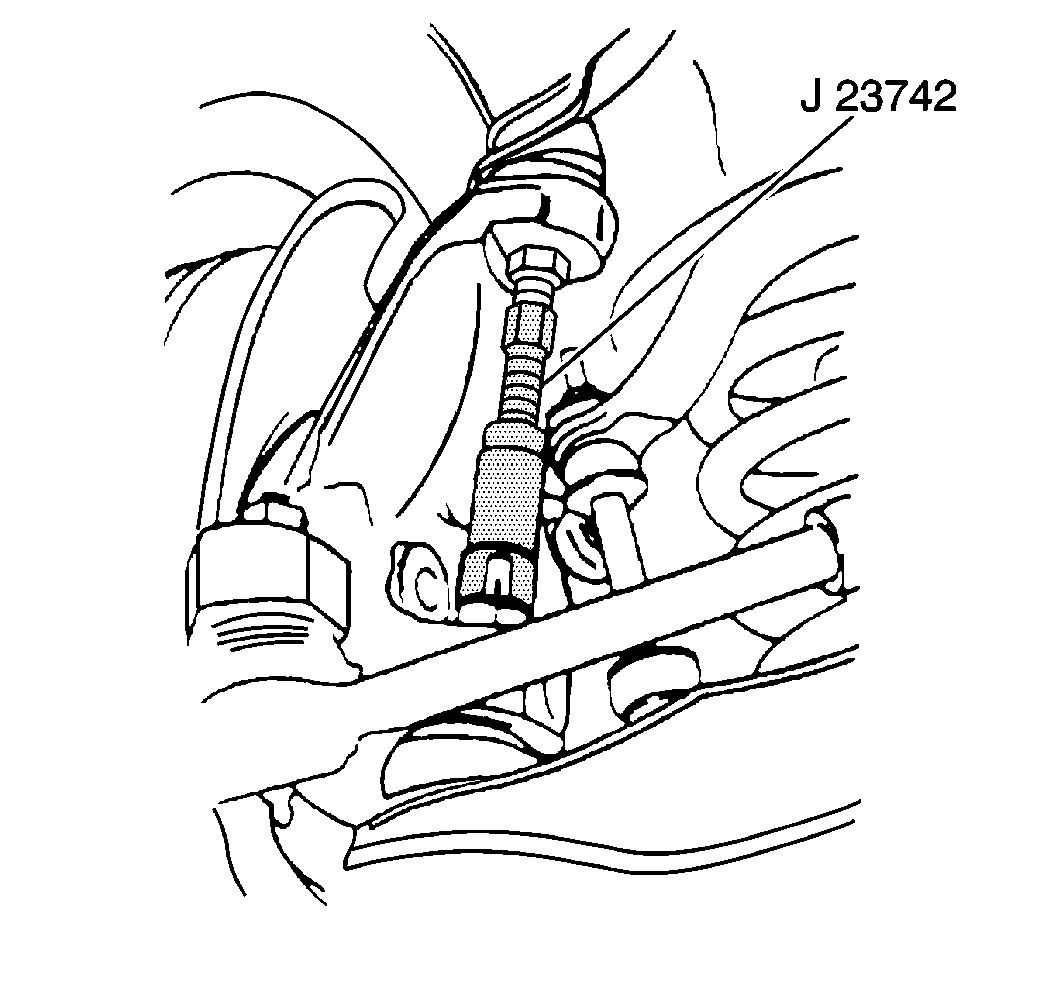
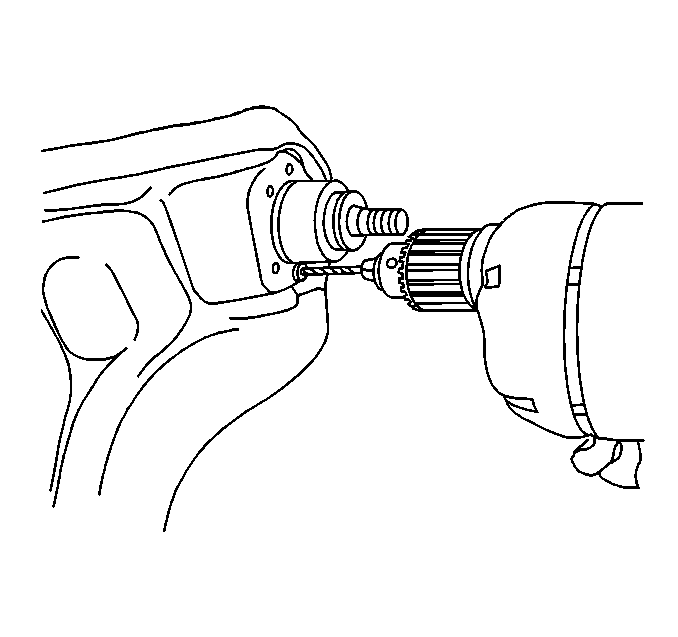
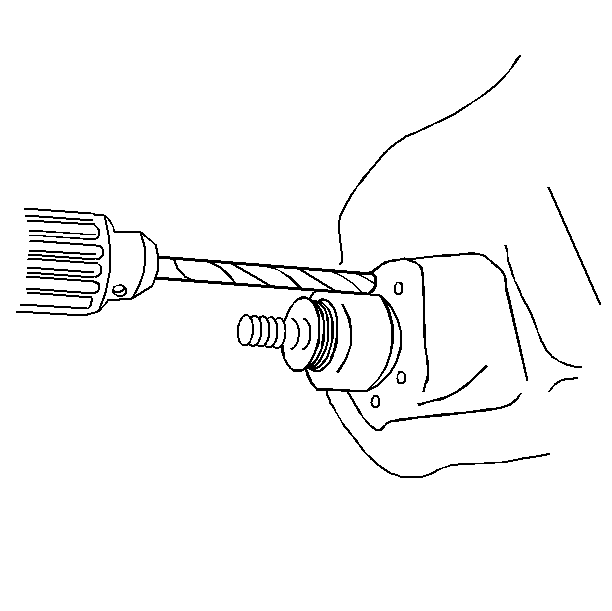
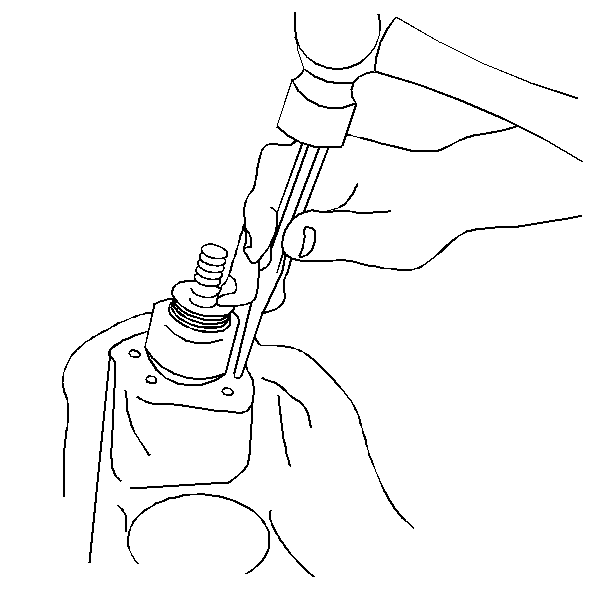
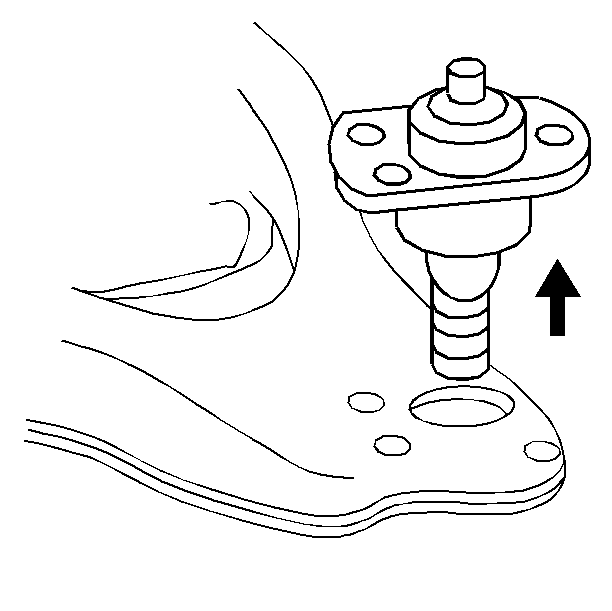
Installation Procedure
- Install a new upper ball joint to the upper control arm.
- Install the antilock brake sensor wire bracket.
- Position four attaching bolts and nuts.
- Remove the support from the knuckle assembly.
- Install the upper ball joint to the steering knuckle.
- Install the stud nut.
- Install a new cotter pin.
- Install the grease fittings.
- Lubricate the ball joint until grease appears at the seal.
- Install the brake caliper. Refer to Brake Caliper Replacement in Disc Brakes.
- Install the tire and wheel assembly. Refer to Wheel Installation in Tires and Wheels.
- Lower the vehicle.
- Check the front wheel alignment. Refer to Wheel Alignment Specifications in Wheel Alignment.
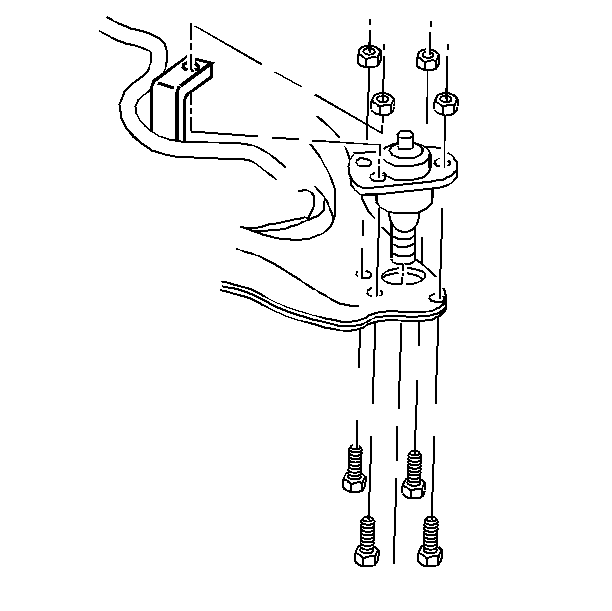
Notice: Use the correct fastener in the correct location. Replacement fasteners must be the correct part number for that application. Fasteners requiring replacement or fasteners requiring the use of thread locking compound or sealant are identified in the service procedure. Do not use paints, lubricants, or corrosion inhibitors on fasteners or fastener joint surfaces unless specified. These coatings affect fastener torque and joint clamping force and may damage the fastener. Use the correct tightening sequence and specifications when installing fasteners in order to avoid damage to parts and systems.
Tighten
Tighten the nuts to 23 N·m (17 lb ft).
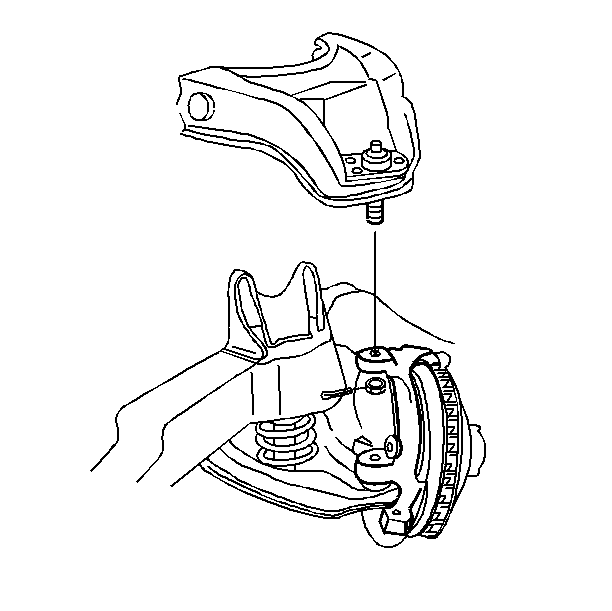
Notice: Use the correct fastener in the correct location. Replacement fasteners must be the correct part number for that application. Fasteners requiring replacement or fasteners requiring the use of thread locking compound or sealant are identified in the service procedure. Do not use paints, lubricants, or corrosion inhibitors on fasteners or fastener joint surfaces unless specified. These coatings affect fastener torque and joint clamping force and may damage the fastener. Use the correct tightening sequence and specifications when installing fasteners in order to avoid damage to parts and systems.
Tighten
| • | Tighten the nut to 83 N·m (61 lb ft). |
| • | Tighten the stud nut in order to align the slot in the stud nut with the hole in the stud. |
Upper Control Arm Ball Joint Replacement S4WD
Removal Procedure
- Raise the vehicle. Support the vehicle with safety stands.
- Remove the tire and wheel. Refer to Wheel Removal in Tires and Wheels.
- Remove the cotter pin from the ball joint stud of the upper control arm.
- Remove the nut.
- Disconnect the ball joint from the knuckle. Refer to Front Wheel Hub, Bearing, and Seal Replacement .
- Remove the rivets from the ball joint.
- Use a 3.175 mm (1/8 in) drill to cut a 6.35 mm (¼ in) deep hole in the center of each rivet.
- Drill the rivet heads away using a 12.7 mm (½ in) drill.
- Remove the rivets using a pin punch.
- Remove the ball joint.
| 3.1. | Loosen, but do not remove, the stud nut on the upper ball joint stud. |
| 3.2. | Loosen the stud from the knuckle. |
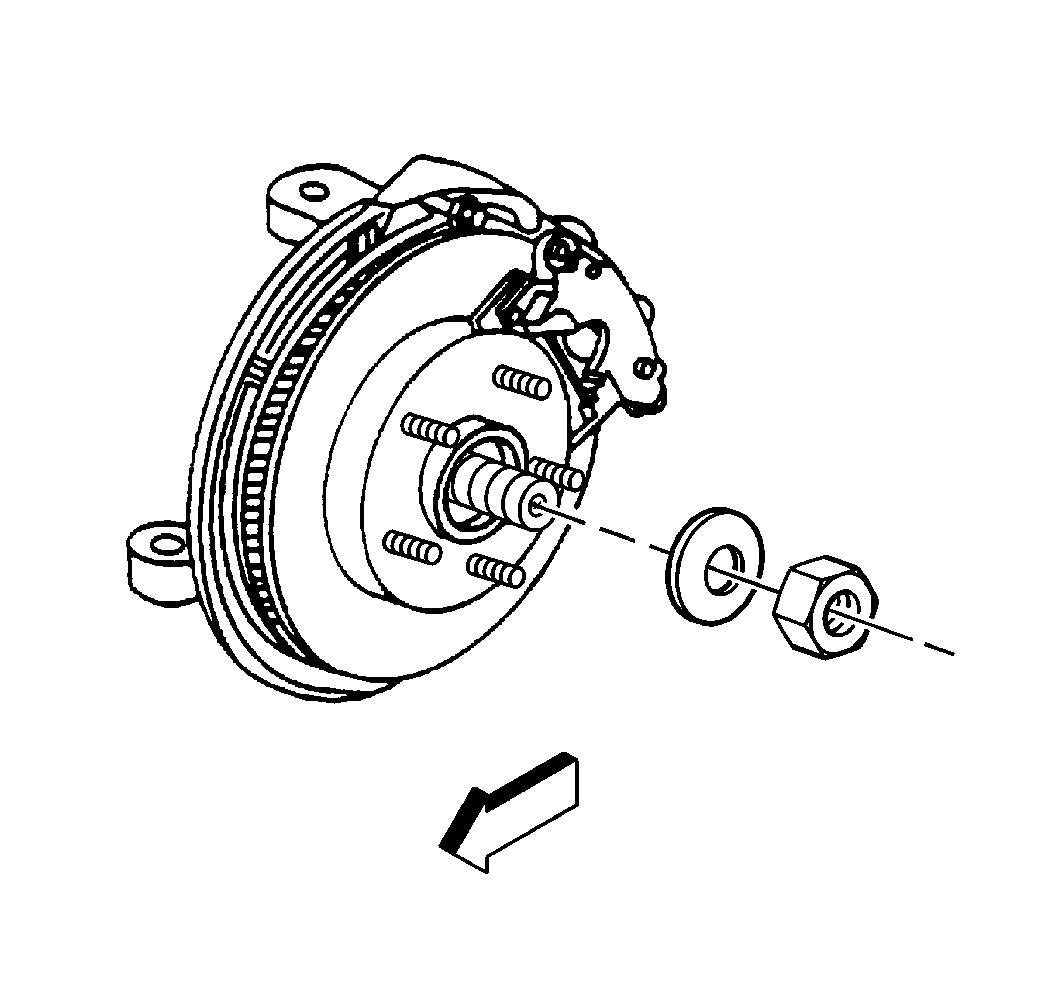
| 5.1. | Tip the knuckle out and toward the rear of the vehicle. |
| 5.2. | Suspend the knuckle from the upper control arm in order to prevent straining the brake line. |



Installation Procedure
- Install the ball joint to the upper control arm.
- Install the bolts and the nuts to the ball joint.
- Install the ball joint to the knuckle.
- Install the upper ball joint to steering knuckle nut.
- Install new cotter pin. Bend the pin ends against the nut.
- Install the tire and the wheel. Refer to Wheel Installation in Tires and Wheels.
- Lower the vehicle.
- Check the front wheel alignment. Refer to Wheel Alignment Specifications in Wheel Alignment.
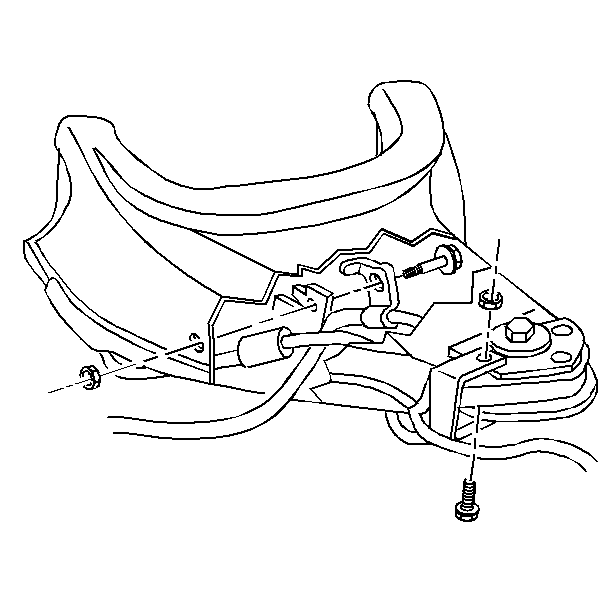
Notice: Use the correct fastener in the correct location. Replacement fasteners must be the correct part number for that application. Fasteners requiring replacement or fasteners requiring the use of thread locking compound or sealant are identified in the service procedure. Do not use paints, lubricants, or corrosion inhibitors on fasteners or fastener joint surfaces unless specified. These coatings affect fastener torque and joint clamping force and may damage the fastener. Use the correct tightening sequence and specifications when installing fasteners in order to avoid damage to parts and systems.
Tighten
Tighten the nuts to 23 N·m (17 lb ft).
Notice: Use the correct fastener in the correct location. Replacement fasteners must be the correct part number for that application. Fasteners requiring replacement or fasteners requiring the use of thread locking compound or sealant are identified in the service procedure. Do not use paints, lubricants, or corrosion inhibitors on fasteners or fastener joint surfaces unless specified. These coatings affect fastener torque and joint clamping force and may damage the fastener. Use the correct tightening sequence and specifications when installing fasteners in order to avoid damage to parts and systems.
Tighten
| • | Tighten the nut in order to align the cotter pin. Do not tighten the nut more than 1/6 turn. |
| • | Lower the nut to 108 N·m (79 lb ft). |
| • | Tighten the upper nut to 83 N·m (61 lb ft). |
